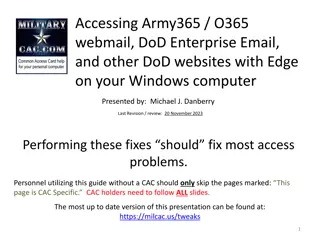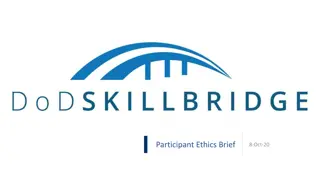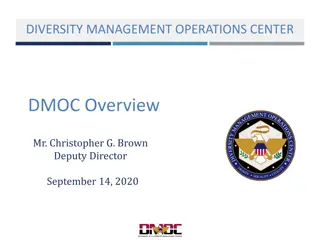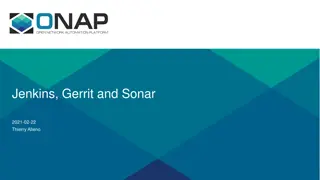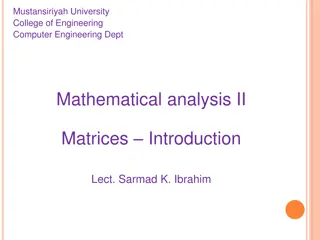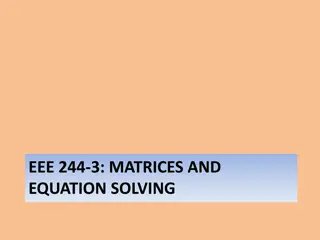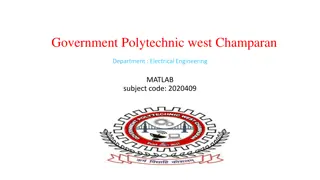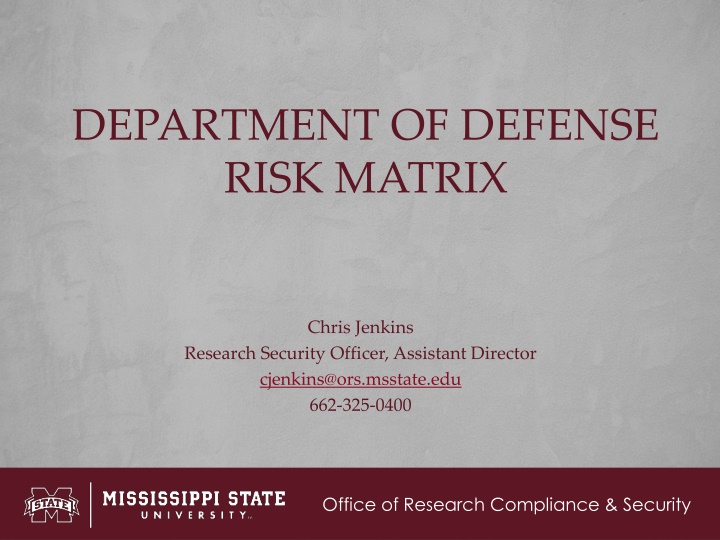
Department of Defense Risk Matrix: Foreign Influence in Research
Learn about the Department of Defense's risk matrix to counter unwanted foreign influence in fundamental research at institutions of higher education. Explore key factors, risk indicators, mitigation strategies, and prohibited factors affecting research funding eligibility. Stay informed to ensure compliance with DoD guidelines and protect U.S. national security interests.
Download Presentation

Please find below an Image/Link to download the presentation.
The content on the website is provided AS IS for your information and personal use only. It may not be sold, licensed, or shared on other websites without obtaining consent from the author. If you encounter any issues during the download, it is possible that the publisher has removed the file from their server.
You are allowed to download the files provided on this website for personal or commercial use, subject to the condition that they are used lawfully. All files are the property of their respective owners.
The content on the website is provided AS IS for your information and personal use only. It may not be sold, licensed, or shared on other websites without obtaining consent from the author.
E N D
Presentation Transcript
DEPARTMENT OF DEFENSE RISK MATRIX Chris Jenkins Research Security Officer, Assistant Director cjenkins@ors.msstate.edu 662-325-0400 Office of Research Compliance & Security
Bottom Line Up Front DoD is acting to counter unwanted foreign influence in fundamental research through their June 2023 memo: Countering Unwanted Foreign Influence in Department-Funded Research at Institutions of Higher Education. DoD will analyze risk of each proposal through four key factors: Participation in Malign Foreign Government Talent Recruitment Programs (MFGTRPs), funding sources, patents, and entity lists. After August 9, 2024, researcher associations with malign foreign talent recruitment programs and institutional failure to have a policy prohibiting these associations will be considered a prohibited factor and the project will not be funded. Office of Research Compliance & Security
Risk Factors Malign Foreign Government Talent Recruitment Programs (MFGTRPs) Indicators the covered individual is participating in a MFGTRP as defined in the Chips and Science Act. Funding Sources Indicators the covered individual is receiving funding from a foreign country of concern (FCOC) or a FCOC-connected entity. Funding is going to be the most complicated to figure out regarding DoD policy. There are many ways to be a FCOC-connected entity and there has been no guidance on what exactly that phrase means. Patents Patent application(s) or patent(s) resulting from USG-funded research that were filed in a FCOC prior to filing in the U.S. or filed on behalf of a FCOC-connected entity. Entity Lists Indicators the covered individual association with an entity or person on U.S. Department of Commerce Entity List, EO 14032 or superseding EOs, Section 1260H of the 2021 NDAA, or Section 1286 of 2019 NDAA. Office of Research Compliance & Security
DoD Risk Matrix (partial) The four main time frames under consideration are: Prior to 10 October 2019 10 October 2019-9 August 2022 After 9 August 2022 After 9 August 2024 Activities and associations prior to 10 October 2019, mitigation is suggested. Between 10 October 2019 and 9 August 2022, mitigation is recommended. After 9 August 2022, mitigation is required to avoid proposal rejection. If there are associations/activities with MFGTRPs after 9 August 2024, the proposal will be rejected. Office of Research Compliance & Security
Risks to U.S. National Security, per DoD Universities (China) Academy of Military Science Beijing Aeronautical Manufacturing Technology Research Institute Beijing Computational Science Research Center Beijing Institute of Technology Beihang University Beijing University of Posts and Telecommunications Center for High Pressure Science and Technology Advanced Research Chinese Academy of Sciences Harbin Engineering University Harbin Institute of Technology Hefei National Laboratory for Physical Sciences at the Microscale Nanjing University of Aeronautics and Astronautics Nanjing University of Science and Technology National University of Defense Technology Northwestern Polytechnical University Ocean University of China Sichuan University Sun Yat-Sen University Tianjin University University of Electronic Science and Technology of China Malign Foreign Talent Plans Changjiang Scholar Distinguished Professorship Hundred Talents Plan Pearl River Talents Plan Project 5-100 River Talents Plan Thousand Talents Plan OR Any program that is sponsored by China, Russia, Iran, or North Korea AND requires an individual to take on one or more of the following: Unauthorized transfer of intellectual property or other nonpublic information Recruit trainees or researchers to enroll in such program Establishing a laboratory/appointment in a foreign country in violation of terms and conditions of a Federal research award Inability to terminate Overcapacity/overlap/duplication Mandatory to obtain research funding from the foreign government s entities Omitting acknowledgement of US home institution/funding agency Not disclosing program participation Conflict of interest/commitment Sponsored by a country of concern (listed above) Office of Research Compliance & Security
New Actions Moving Forward DoD MSU DoD Components will review at least three sets of information Researcher disclosures and Standard Form 424 submitted for all Covered Individuals Publicly available information Information in Research Performance Progress Reports for funded projects. They reserve the right to review any other information as deemed necessary. P.I.s must be tracking their publicly available profiles. Know who you are connected to and who your connections are connected to. Disclose public relationships on the SF 424. Be prepared to respond: If DoD determines there is a high enough risk, the MSU P.I. will have to work with the Research Security Office to create a mitigation plan. DoD Components will conduct periodic spot checks of Covered Individuals on samples of FRPPs to identify any missed research security issues. Office of Research Compliance & Security
Takeaways Fundamental research is being increasingly scrutinized by DoD. DoD will conduct risk assessments on all fundamental research proposals AFTER they have been selected to be awarded Association/activities risk levels increase the more recent they occur. Know what your open source profile say about you. After August 9, 2024, MSU must have a policy that prohibits participation in Malign Talent Plans Office of Research Compliance & Security
Questions Chris Jenkins Research Security Officer, Assistant Director cjenkins@ors.msstate.edu 662-325-0400 Office of Research Compliance & Security



